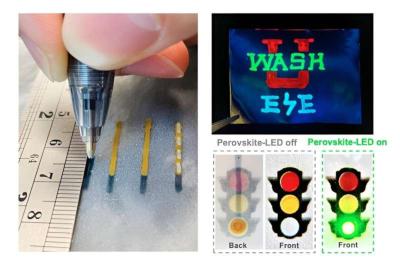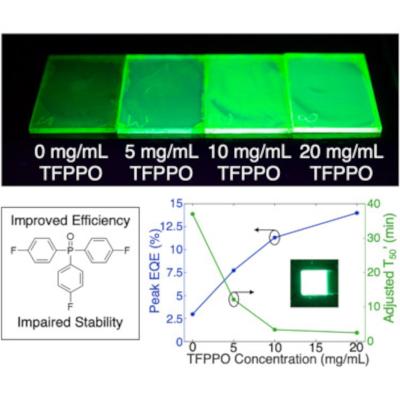Perovskite LEDs - recent news - Page 4
Researchers develop tandem perovskite light-emitting diodes
Researchers at Seoul National University and Korea Advanced Institute of Science and Technology (KAIST) have developed highly efficient tandem perovskite light-emitting diodes (PeLEDs). This advancement may expedite the commercialization of perovskite light-emitting materials in next-generation display technologies.
The Ministry of Science and ICT (MSIT) announced that the team, led by Professor Lee Tae-woo from Seoul National University’s College of Engineering, has successfully created a high-efficiency and long-life hybrid tandem light-emitting device. This device combines metal halide perovskites with organic light-emitting diodes.
Researchers report electrically assisted amplified spontaneous emission in perovskite LEDs
Researchers at Imec have reported a metal halide perovskite LED (PeLED) stack that emits 1,000x more light “than state-of-the-art OLEDs”. The team developed a transparent PeLED architecture, that combines low optical losses with excellent current-injection properties.
In this work, the team showed that perovskite semiconductor optical amplifiers and injection lasers are within reach using this type of transparent PeLED.
Researchers report perovskite LEDs based on MoS2 backplane TFTs
Researchers at Yonsei University and Korea University have integrated perovskite films with two-dimensional electronics to address current obstacles that hinder the commercialization of perovskite LEDs (PeLEDs).
The scientists developed centimeter-scale integrated PeLED displays achieving key metrics on par or better than existing standards. This work suggests the potential transition of PeLEDs from lab concept to next-generation commercial displays.
Researchers develop synthesis method for better perovskite-based opteoelectronics
It was reported that researchers at the Institute for Advanced Materials at the Universitat Jaume I in Castelló have created a method for synthesizing organic-inorganic tin halide perovskites and generating thin films or coatings from them, which, when deposited on substrates, have optoelectronic properties that are useful for the creation of devices such as perovskite-based LEDs (PeLEDs).
The method developed by the team consisting of Dr. Samrat Das Adhikari and the doctoral student, Jesús A. Sánchez Diaz, and led by the researcher Iván Mora Seró, exhibits excellent photoluminescence and stability properties that are suitable for commercial application in the field of optoelectronic devices (solar cells, LEDs, etc.).
Researchers examine the role of chloride on the instability of blue emitting mixed-halide perovskites
Researchers in Sweden and China have studied the reasons behind the short operational lifetime of blue perovskite-based LEDs (PeLEDs).
While perovskite light-emitting diodes (PeLEDs) have seen unprecedented development in device efficiency over the past decade, they still suffer from poor operational stability. This is especially true for blue PeLEDs, whose operational lifetime remains orders of magnitude behind their green and red counterparts. The scientists in this work have systematically investigated this efficiency-stability discrepancy in a series of green- to blue-emitting PeLEDs based on mixed Br/Cl-perovskites. Typically, mixed chloride/bromide perovskites are employed to produce ideal blue emission. However, the researchers have uncovered a counterintuitive fact: even minute quantities of chloride loading can have a dramatic negative impact on the operational lifetime of these devices.
Researchers use perovskites to develop “multielement ink” – a “high-entropy” semiconductor that can be processed at low-temperature or room temperature
Researchers from Lawrence Berkeley National Laboratory (Berkeley Lab) and UC Berkeley have developed room-temperature-solution (20 °C) and low-temperature-solution (80 °C) synthesis procedures for a new class of metal halide perovskite high-entropy semiconductor (HES) single crystals. The “multielement ink” could enable cost-effective and energy-efficient semiconductor manufacturing and accelerate the sustainable production of next-gen microelectronics, photovoltaics, solid state lighting, and display devices.
“The traditional way of making semiconductor devices is energy-intensive and one of the major sources of carbon emissions,” said Peidong Yang, the senior author on the study, a faculty senior scientist in Berkeley Lab’s Materials Sciences Division and professor of chemistry and materials science and engineering at UC Berkeley. “Our new method of making semiconductors could pave the way for a more sustainable semiconductor industry.”
Researchers report self-assembled monolayer–based blue perovskite LEDs
Researchers from the University of Toronto, Peking University and Soochow University have studied the origins of unwanted emission in monolayer perovskite LEDs when the active layer thickness approaches ~5 nm and found that using available fabrication techniques results in a rough perovskite/HTL interface which leads to punch-through and direct electrical interaction between HTL and ETL (electron-transporting layer), and consequently, to undesired exciplex emission in LEDs.
The team sought to control monolayer interfaces in Rec.2100 primary blue perovskite LEDs and recognized that a well-defined, ordered, and compact monolayer film could suppress HTL/ETL interaction. They reasoned that this could be achieved if they could alter the polarity of the CsPbBr3 c-NC surface and thereby induce perovskite self-assembly down to the monolayer limit [i.e., self-assembled monolayer (SAM)] through the use of an HTL-compatible ligand. Self-assembled films with ordered nanocrystal arrangement maximize the interactions between nanocrystals and provide homogeneity needed for monolayer films with ~5-nm thickness.
Researchers design novel quantum random number generation based on a perovskite light emitting diode
Researchers from Linköping University in Sweden and Universidad de Concepción in Chile recently designed a new type of random number generator for encryption, based on Perovskiye LEDs. The new technology could make digital information exchange safer, cheaper and more environmentally friendly and even pave the way for a new type of quantum communication.
To encrypt information, a random number generator is used, which can either be a computer program or the hardware itself. The random number generator provides keys that are used to both encrypt and unlock the information at the receiving end. Different types of random number generators provide different levels of randomness and thus security. Hardware is the safer option as randomness is controlled by physical processes. And the hardware method that provides the best randomness is based on quantum phenomena – what researchers call the Quantum Random Number Generator, QRNG.
Researchers develop ballpoint pens that can write perovskite LEDs on diverse substrates
Researchers from Washington University in St. Louis and Florida State University have developed a versatile, scalable and eco-friendly handwriting approach to draw multicolor perovskite light-emitting diodes and perovskite photodetectors on various substrates, including paper, textiles, plastics, elastomers, rubber and three-dimensional objects.
The team's method uses common ballpoint pens filled with newly formulated inks of conductive polymers, metal nanowires and multiple perovskites for a wide range of emission colors. Just like writing with multicolored pens, writing layer-by-layer with these functional inks enables perovskite optoelectronic devices to be realized within minutes.
Researchers explore the effects of a molecular additive for perovskite LEDs
Researchers from Stanford University and Mississippi State University recently explored the potential of Mn2+-doped perovskite LEDs (PeLEDs) for lighting and display applications.
By introducing a molecular additive, tris(4-fluorphenyl)phosphine oxide (TFPPO), Mn2+-doped PeLEDs achieved a peak external quantum efficiency of 14.0% and peak luminance (i.e., brightness) of 128,000 cd/m2. These high efficiencies and brightnesses suggest that Mn2+-doped PeLEDs could be implemented in lighting or display applications. However, device stability is also important to consider. The team found that introducing TFPPO compromises the stability of Mn2+-doped PeLEDs—a decrease from 37.0 to 2.54 min. By analyzing both the optoelectronic and photophysical characteristics of Mn2+-doped PeLEDs before and after device operation, the scientists reported insights into this efficiency-stability trade-off.
Pagination
- Previous page
- Page 4
- Next page





